Astronomy has traditionally relied on capturing photons from cosmic sources to be able to understand the universe. During the 20th and 21st centuries, different messengers have been added to the astronomer's toolset: cosmic rays, neutrinos, and most recently gravitational waves. Each of these messengers opens a new window on the universe, and a modern astronomer must be familiar with them. The goal of this book is to provide a broad understanding of these messengers and their relationship to each other. The unique physics of each messenger is introduced, as well as the physics of their detection and interpretation. An additional focus is the discussion of techniques and topics that are common to more than one messenger. Principles of Multimessenger Astronomy is designed to be both an introduction and reference to modern astronomy.
Key Features
Key Features
- Provides a general reference for all astronomers interested in multimessenger observational astronomy and astrophysics, as well as a teaching resource
- Explores foundation topics that are useful across messenger and waveband boundaries
- Includes scientific history, and the operation and use of modern astronomical instrumentation
- Introduces the use of data from multiple messengers
Dieser Download kann aus rechtlichen Gründen nur mit Rechnungsadresse in A, D ausgeliefert werden.


